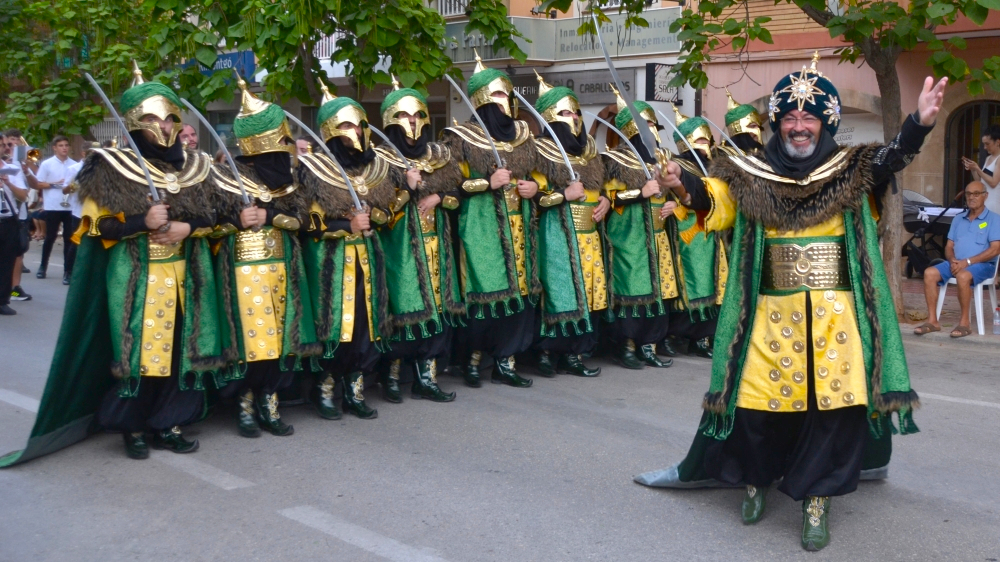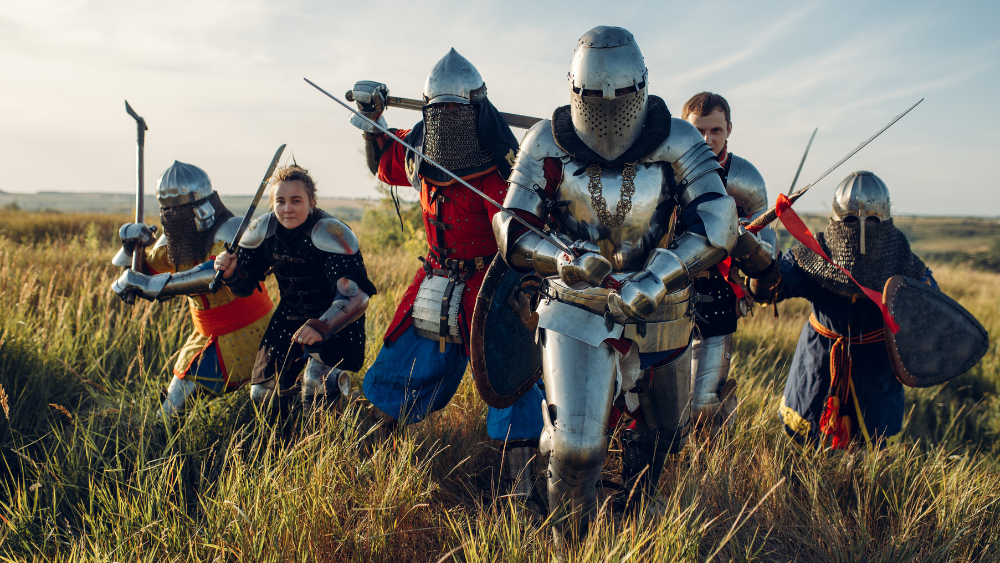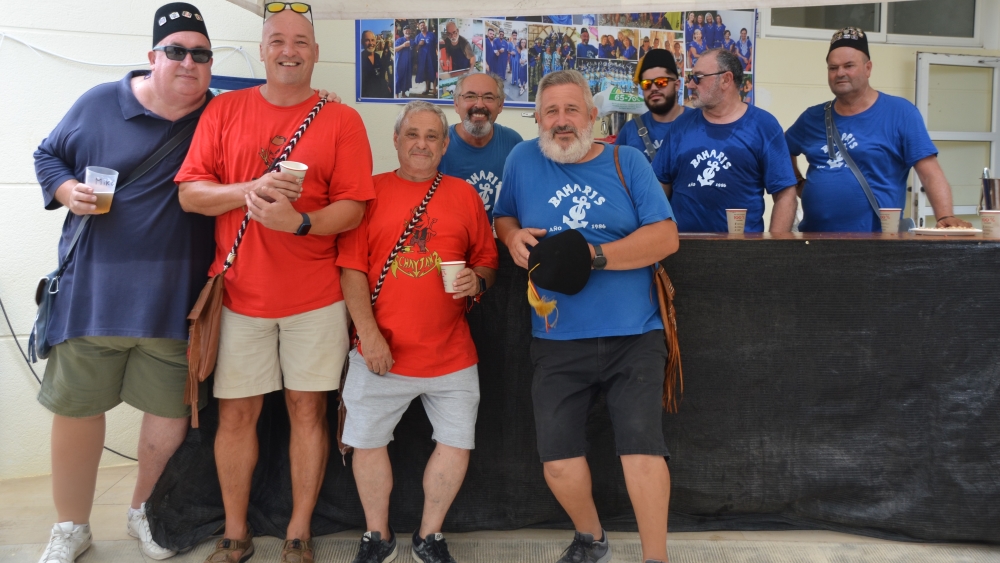

Introduction
Whilst the colourful fiestas of the Moors and Christians, which is celebrated mainly in the southern Valencian region, serve primarily as a reminder of a period of history when much of Spain was under the control of Muslim powers, they also recall the daily struggle against Muslim Barbary pirates who prowled the Mediterranean coast between the 15th and 17th centuries. Indeed, the village of Jávea was once a walled stronghold to protect its citizens against such marauders, tall defences that were only removed in the mid-19th century once the danger has passed.
In essence, the fiesta celebrates the success of the “Reconquista”, the ultimate triumph of Christian forces over who were considered as Islamic invaders in 1492, and the strengthening of the Christian faith, whilst also acknowledging the culture that controlled much of Spain for over 780 years.
A Short History

The roots of the Moors & Christians stretch back more than 500 years, beyond the success of the “Reconquista” and in some areas have developed from older traditions over 800 years old. The oldest documented reference to a confrontational celebration dates back to 1150 where the town of Lérida in Catalonia marked the wedding of Ramón Berenguer IV, count of Barcelona, with Petronila, daughter of the King of Aragon Ramiro II, with an allegorical dance which referred to the battle between Christians and Muslims.
There is documented evidence of a mock battle being fought between two sets of troops from Jaime II’s forces to celebrate the liberation of Ceuta from Muslim rule on July 25th 1309, the men fighting for possession of a wooden castle erected in the middle of the city square. At first, victory went to those representing the Moorish side before the miraculous and sudden appearance of San Jorge on his white horse encouraged those representing the Christian forces to make a counter-attack and take the castle.
Such simulations of the battle between the crescent and the cross to commemorate Christian victory over the Muslims are documented elsewhere across the peninsular over the next few centuries. In 1373, a visit of the Dukes of Gerona, heirs to the Crown of Aragon, to Valencia was commemorated with a simulated nautical-land battle featuring a castle and two galleys, whilst a visit of the Catholic Monarchs to Murcia in 1448 was honoured with a similar theatrical act. And in 1493, Gerona celebrated the taking of the city of Granada and the fall of the Nasrid Emirate the previous year with a simulated battle between two sides representing the Christians and the Muslims.
However, the oldest documented reference to the festival of the Moors and Christians as we would recognise it today speaks of an act which took place during the Easter celebrations in Jaén in 1462. Broadly following the same structure of modern versions, it featured diplomatic discussions, a tournament between knights dressed as both Christians and Muslims, a battle of the blunderbusses, and finally the conversion of the “king of Morocco” to Christianity.
Moors and Christians festivals were also documented in Toledo (1553), Madrid (1570), Segovia (1578), Orihuela (1579, 1580 and 1586), Valencia (1586), Dénia (1599), Villena (1638) and Alcoy in 1668. The latter recorded eleven more such festivities over the next 120 years and has become one of the biggest examples of the Moors & Christians, a huge event which was declared a ‘Fiesta of International Tourist Interest’ by the Spanish Government in 1980, one of the first fiestas to be honoured with such a title after its establishment in 1979.
The development of the modern concept of the fiesta can also be attributed to the ancient tradition of the “Soldadesca” when local militias carried out military parades and displays to mark a special occasion, such as a visit of the king, a royal anniversary or the birth of a royal child. In some towns, these military acts were carried out to honour the patron saint on the occasion of their feast day.
It was during the second half of the 19th century and into the early years of the 20th century that the Moors and Christians festivals began to be officially celebrated as such, following more or less the same format that we know today. And it was particularly in the southern half of the Comunidad Valenciana that these festivities were celebrated with great enthusiasm.
During the 1950s, self-regulation limited the historical setting of the celebrations to the Reconquista, removing the emergence of troops from Flanders, the smugglers of the War of Independence, and even cowboys from the Wild West.
Both San Jorge (St George) and San Jaime or Santiago (St James) often play an important part in these festivities.
- During the Battle of Alcoy in 1276, San Jorge was said to have appeared on horseback on the city walls as Christian troops fought to defend their city from the Marinid forces of Muslim warlord Al-Azraq, resulting in the besiegers fleeing in fear. The date was April 23rd, the saint’s feast day, and the people of Alcoy named San Jorge as the patron saint of the city and the Moors & Christians festivities are held in April every year in his honour.
- San Jaime was said that to have appeared alongside Christian troops during many battles against Islamic forces, particularly at the decisive Battle of Las Navas de Tolosa in July 1212 which was an important turning point in the medieval history of Spain. He became known as ‘Matamoros’ – the Moorslayer – and he remains Spain’s patron saint. The feast day of San Jaime is July 25th so some festivals, like that of Jávea, take place during this month.
The Format
Each town has its own peculiarities but in general the fiesta is celebrated is very much the same way. The participants split themselves into the Moors and the Christians, creating components known as ‘filaes‘. Each side symbolically takes the town under its control, the Moors first and then, normally on the following day, the Christians retake it.
The filaes are funded entirely by membership fees and the fund-raising efforts of its members, usually through selling national lottery tickets for which the ‘fila’ receives a commission. The cost and thus commitment can be incredible; those in Alcoy can expected to pay around 1,500 euros per year to be part of a fila; most of those in Jávea contribute considerably less but it’s still a huge financial responsibility. Membership is a year-long commitment, raising funds, organising banquets and planning the activities that will make up this fiesta. You become part of a special family, working together to make the next parade even better.

Each company creates its own base of operations known as ‘kábilas‘ if you’re a Moorish fila, or ‘cuarteles‘ (barracks) if you’re Christian. Like the penya casals of Sant Joan, most are these headquarters are temporary affairs, the company members renting a vacant premises for a week or so, although most rent the same space year after year. Those well-established ‘filas’ have more permanent bases with bars and fully-equipped kitchens, the walls decorated with photos from previous events.
Moros i Cristians de Xàbia – A History
The first Moors and Christians fiesta took place in 1978 and featured just one fila – Filà Jalufos – that paraded alone through the streets of the town. A year later, they paraded during the festivities of San Juan and the enthusiastic response to their presence encouraged the development of an idea, although their participation in the midsummer celebrations was short-lived since concerns over the slow speed of the Moorish march meant that they couldn’t take part in the parades again.
In 1981 the Christian Filà Trabuquers was formed, providing a balance, and the two sides paraded in the festivities honouring the patron saint of Aduanas del Mar (the port) but they experienced more opposition as some of those active in those celebrations honouring the Virgen de Loreto felt that the participation of these two filaes went against the religious nature of their fiesta.
In 1982, a third group was created, Filà Almoradins, and the mayor of Jávea at the time, Enrique Bas Espinós, suggested that the groups look to create their own fiesta, pledging to provide municipal funding if they considered holding the celebrations in July, ostensibly to honour San Jaime, whose feast day falls on July 25th, but also to become part of the tourism potential for the town.
The first Moors & Christians took place in July 1983 with four groups: Filà Jalufos and Filá Almoradins representing the crescent whilst Filà Trabuquers and the newly-formed Filà Ballesters representing the cross. The two parades caused great excitement amongst tourists and the festivities were legalized with statutes and the formation of the Junta Central de Fiestas de Moros y Cristianos de Jávea to take care of the organisation.
Over the next few years, several more groups were formed: Filà Taureg, Filà Mora Negres, Filà Baharis, Filà Xabiques, an all-female group, and Filà Almoriscos. Of these, only two remain: Baharis and Almoriscos.
In 1991, the first captaincy was awarded to Filà Almoradins (Francisco Carmelo Cholbi Serrat and Rosa María Segarra) and, from then on, the responsibility would rotate amongst the filaes, mostly – but not always – alternating between Moorish and Christian groups. The oldest filaes – Almoradins, Almoriscos, Baharis and Ballesters – have all held the role four times.
The second half of the 90s saw the formation of Filà Els Castellers (which would fold within by the end of the decade), Filà Al-Tariks, Fila Pirates de Sant Jaume i Sant Joan, a group created by the quintos of 1998, whilst the turn of the century saw the emergence of Filà Contrabandistes de Xàbia, Fila Almogàvers, Filá Schaitans, Filà Christians dels Tossals, Filà Bandolers, and Filà Cristians Vells.
In 1996, the first Mig Any celebration took place, a chance to prepare the groups for the forthcoming fiesta, to award prizes and distinctions and a moment that would be celebrated with a gala dinner and a time of camaraderie.
In 1997, the first standard bearers were proclaimed, representatives for each side who would also represent the fiesta alongside the captains at other celebrations in the town: the first standard bearers were Ana Parrilla Carrasco (Moor) and Sara Junquera Rodríguez (Christian). In 2022, the 25th anniversary of their first appearance in the fiesta, almost all the standard bearers since 1997 were honoured on stage in a special ceremony during the presentation evening of that year’s festivities.
In 2003, the fiesta celebrated its 25th anniversary and, although the captaincy belonged to Filà Contrabandistes, it was decided to hand over the honour to Filà Jalufos as pioneers of the Moros i Cristians de Xàbia and as the first ever filà to be created. Sadly, the Jalufos folded in 2022, a victim of the pandemic as it struggled to find willing participants to continue its presence once normality returned to the world.
In 2014, the first Premios Sant Jaume were awarded to three people each year to honour and acknowledge their dedication to the fiesta. Candidates are presented to the general meeting by the filaes for selection for each year.
The current components in 2024
The Moors
Almoradins (1982)
Almoriscos (1986)
Al-Tarik’s (1995)
Baharis (1986)
Schaitans (2000)
Xibia (2005)
The Christians
Ballesters (1983)
Bandoleres (2023)
Contrabandistes de Xàbia (2000)
Faciners (2013)
Pirates de Sant Jaume (1998)
Trabuquers (1980)
Moros i Cristians de Xàbia – The Format

- MIG ANY – Getting Ready for Fiesta
- The Presentation
- The Music and the Arenal
- The Flower Offerings
- The Invasion
- The Reconquest
- The Parades
- Becoming a Moor

A POTTED HISTORY
The land that the Berber soldiers from North Africa invaded in 711 was a Christian Visigothic kingdom and the remnants of the defeated would give birth to the Kingdom of Asturias, whose founder Pelayo is credited with kick-starting the Reconquista after defeating Muslim forces at the Battle of Covadonga. After conquering much of the Iberian peninsula, internal disputes and civil wars across the Islamic state of Al-Andalus fragmented it into a number of minor states and principalities, allowing Christian kingdoms in the north to gradually overpower their Muslim neighbours in the south. By the end of the 11th century, Al-Andalus was in decline and with the fall of Córdoba in 1236, the Emirate of Granada was the only Muslim territory left. On January 2nd 1492, Emir Muhammad XII surrendered the Emirate to Ferdinand II of Aragón and Isabella I of Castille, the ‘Catholic Monarchs’.
